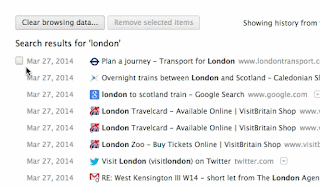Here’s a collection of 15 most useful tips and tricks for Google Chrome that will help you work faster and do more with your favorite web browser. You don’t have to install any extensions. It’s a big list so let’s dive right in.
1. Save web pages as PDFs
Google Chrome has a built-in PDF writer. Open any web page, press Ctrl+P on Windows (or Cmd+P on your Mac) and choose “Save as PDF” from the list of available printers to download that page as a PDF file. No extensions required.
2. Assign custom keyboard shortcuts
Google Chrome supports a variety of keyboard shortcuts but you can also assign your own custom shortcuts to launch various extensions and Chrome apps. Typechrome://extensions in the browser’s address bar to open the Extensions page, scroll to the bottom and click the link that says Keyboard Shortcuts.
3. Delete your web history selectively
Google Chrome’s history (chrome://history) doesn’t have a “Select All” button so if you are to delete, say, 20 pages from the history log, you’ll have to select 20 checkboxes. The trick is that you select the first checkbox, hold shift and select the last checkbox. Everything in between will get selected.

4. Install unapproved Chrome extensions
The newer versions of Chrome do not allow you to install extensions that are not listed in the official Google Chrome store. As a workaround, you can open the Extensions page of Chrome, turn on the Developer mode and drag-n-drop the extension (the .crx file) into your Chrome.
5. Quick Fix for Slow Chrome
Google Chrome may feel sluggish after several hours of continuous usage. The easiest fix is to restart your browser but sometimes the culprit could be a poorly coded extension or even a website. The clue can be found under Tools -> Task Manager. Sort the list by Memory, select the websites and extensions that are consuming more memory and click End Process.
6. Fake your current location
Certain websites, Google Maps for example, may ask the browser for your geographic location. You can choose not to share this data with the website or you may even fake your current location. Go to Tools -> Developer Tools and press the Esc key to open the console. Here switch to the Emulation tab and enter any value for latitude and longitude.
7. Reveal all your hidden passwords
Google Chrome can remember and auto-fill your passwords but they are masked with asterisks. If you would like to reveal a hidden password, open the Developer Tools, visually select the password field on the page and change the input type from password to text. Alternatively, you may find your saved passwords underchrome://settings/passwords.
4. Install unapproved Chrome extensions
The newer versions of Chrome do not allow you to install extensions that are not listed in the official Google Chrome store. As a workaround, you can open the Extensions page of Chrome, turn on the Developer mode and drag-n-drop the extension (the .crx file) into your Chrome.
5. Quick Fix for Slow Chrome
Google Chrome may feel sluggish after several hours of continuous usage. The easiest fix is to restart your browser but sometimes the culprit could be a poorly coded extension or even a website. The clue can be found under Tools -> Task Manager. Sort the list by Memory, select the websites and extensions that are consuming more memory and click End Process.
6. Fake your current location
Certain websites, Google Maps for example, may ask the browser for your geographic location. You can choose not to share this data with the website or you may even fake your current location. Go to Tools -> Developer Tools and press the Esc key to open the console. Here switch to the Emulation tab and enter any value for latitude and longitude.
7. Reveal all your hidden passwords
Google Chrome can remember and auto-fill your passwords but they are masked with asterisks. If you would like to reveal a hidden password, open the Developer Tools, visually select the password field on the page and change the input type from password to text. Alternatively, you may find your saved passwords underchrome://settings/passwords.
If you are to write a new email in Chrome, you’ll open the Gmail website and hit the compose button. Alternatively, just go to the browser’s address bar and type the mailto command like mailto:recipient@domain.com. This will open the Gmail compose window and auto-fill the address in the To field.
9. Take notes inside Chrome
9. Take notes inside Chrome
While there are some good Chrome extensions that add notepad-like capabilities to your browser, there’s a little JavaScript hack that will instantly turn your Chrome into a text editor. Open a new tab and paste data:text/html,







